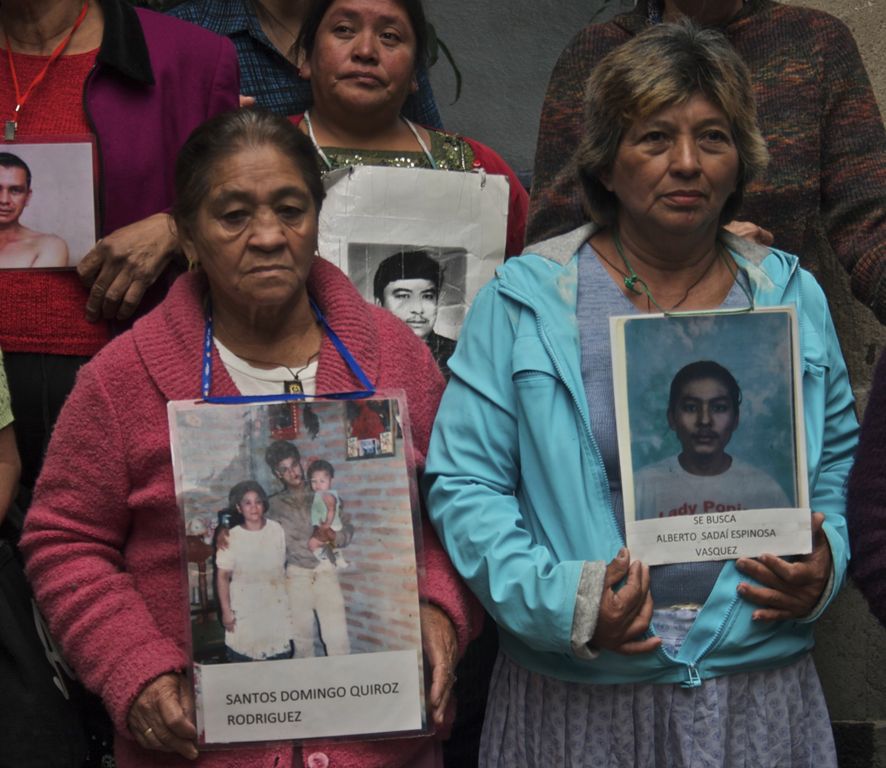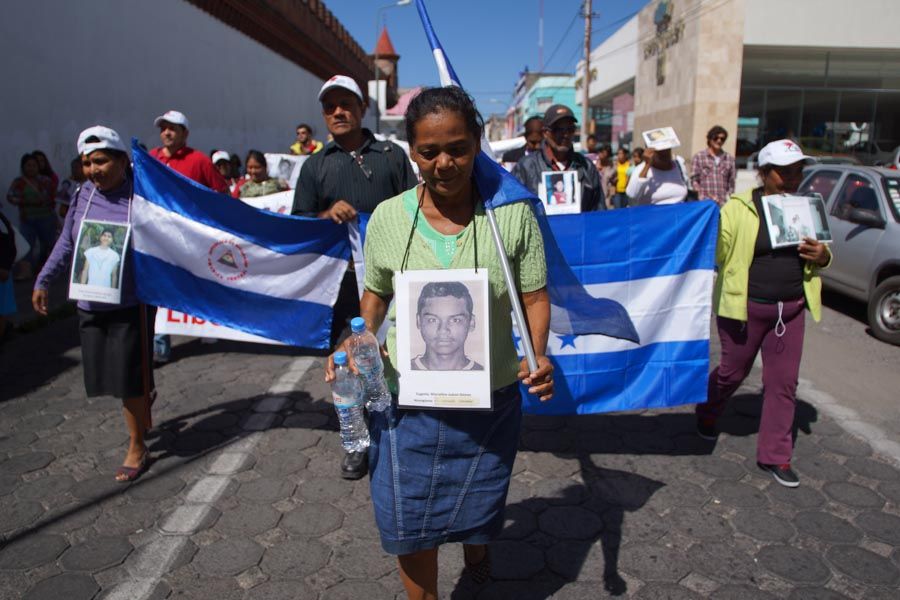
Called “Freeing Hope,” this caravan of 38 mothers — which began on October 15 and ended on November 3 — traveled through El Salvador, Nicaragua, Honduras, Guatemala and across what is known as the “Migrant’s Route” in Mexico. Although many of them have not been able to find their children, they drew attention from the media and authorities, spread awareness of migrants’ issues and put a face to the human rights’ violations that migrants are exposed to on their journeys.
![]() Source: Waging Nonviolence
Source: Waging Nonviolence
“The things we have in common are that our sons or daughters are disappeared, and that we can organize from our pain, because it gives us courage,” said Mercedes Moreno, a migrant from El Salvador who has lived in Los Angeles since the 1970s. “We too will not rest until we find our children. Many of us also have to raise children while we search for our disappeared. We have a common pain, and we are all Mesoamericans. That’s why our home used to be called Mesoamerica.”
From 1978 into the 1980s, Mercedes organized with the Sandinistas and with the Salvadorans who fled from the civil war to the U.S. “We went to the churches and talked to the community priests, with the neighbors,” she explained, “so that they would listen and understand that we had something in common despite not being from the same country. Now, as mothers, we must do the same.”
Mercedes has not been able to get any information about her son, José Leonidas Moreno, since 1991. She just finished traveling with his photo on the Central American Mothers’ Caravan with 37 other mothers in search of their children, who disappeared in Mexico while traveling to the United States. Some were fleeing armed conflicts, while others found themselves homeless due to natural disasters that leveled all they owned.
Called “Freeing Hope,” this caravan of 38 mothers — which began on October 15 and ended on November 3 — traveled through El Salvador, Nicaragua, Honduras, Guatemala and across what is known as the “Migrant’s Route” in Mexico. This was the eighth such caravan organized by Central American mothers to arrive in Mexico. By the end, they had traveled nearly 3,000 miles, through 14 states and 23 towns, seeing with their own eyes the very landscapes that their children likely crossed while trying to reach the United States.
Although many of them have not been able to find their children, they drew attention from the media and authorities, spread awareness of migrants’ issues and put a face to the human rights’ violations that migrants are exposed to on their journeys.
 On October 28, María Teodora Ñaméndez, or “Teo” as her companions in the caravan call her, excitedly told me about how after 30 years without seeing him, she would be reunited with her son Francisco the following day in Tierra Blanca, Veracuz.
On October 28, María Teodora Ñaméndez, or “Teo” as her companions in the caravan call her, excitedly told me about how after 30 years without seeing him, she would be reunited with her son Francisco the following day in Tierra Blanca, Veracuz.
“I’m going to scold him when I see him,” says Teo. She is 75 years old and just 15 days ago left her native Nicaragua for the first time, to search for her son. “My other sons said their brother was dead. No, son, he is alive, I would tell them. I felt it in my heart. That’s why I joined the Caravan.”
Rubén Figueroa, a human rights defender with the Mesoamerican Migrant Movement (MMM) and participant in the caravan was the one who, after following clue after clue, managed to find Francisco. He explained:
During this years’ Caravan, indications arose over a migrant who since 1985 had not communicated with his mother. I arrived in Veracruz and began following clues. Some neighbors didn’t want to say anything because they were afraid — because they were migrants too. They feel insecure. We followed a few false clues, but eventually we found him. “He might be the son-in-law of a woman I know,” some people told me. I went to visit that woman… She put her hands to her chest, and I knew that Francisco was there. I also talked to his daughter, who said excitedly “my grandmother is looking for her son?”
Francisco arrived a bit later on his motorcycle. “Your mother has been looking for you,” I said. “I thought my mother was dead,” he said. “I thought this sort of thing only happened in telenovelas.”
Francisco Cordero had left Nicaragua at age 17. He had started out in a guerrilla movement. At 19 he went to El Salvador, and from there to Mexico. He had sent lots of cards to his home but his mother only received the first, and the rest were all returned to him. On the day Rubén found him, the people in his neighborhood came to hug him.
Now Francisco is 51 years old, he is married and has three children. Despite her age and having found her son, Teo will not leave the side of the 38 mothers she met on the Caravan. She plans to keep organizing with women who, like her, won’t rest until they find their children. “Now their children are also my children,” she said.
Rubén Figueroa was also a migrant. At 16 years old, he left for the United States and spent five years working in North Carolina. When he came back to Mexico, he and his mother began doing humanitarian work. They fed migrants, gave them shelter, heard the stories of raped women, of kidnappings, extortion and threats. Now he is a human rights defender.
Like him, many mothers of disappeared migrants have become organizers after participating in the caravan. Eméteria, for example, found her daughter on the first mothers’ Caravan two years ago, after not seeing her for 21 years. Despite having found her daughter, she has continued working with other mothers of the disappeared and accompanied them on the latest caravan. She has also created a radio program in her community that demands rights for migrants and encourages listeners to join them in asking for justice. The governments in the region “don’t do their job, and aren’t even interested in doing it, which is why we have to keep organizing,” she comments.
 Carmen Lucia Cuaresma is from Nicaragua, but lives in Costa Rica. She is searching for her son Álvaro Enrique Guadamos Cuaresma. The last time she heard his voice was in March of last year over the phone. He was asking for $2,000 dollars.
Carmen Lucia Cuaresma is from Nicaragua, but lives in Costa Rica. She is searching for her son Álvaro Enrique Guadamos Cuaresma. The last time she heard his voice was in March of last year over the phone. He was asking for $2,000 dollars.
“Where am I going to get that money if I’m poor? And I asked myself, could it be that he was kidnapped?” Carmen lamented. “We are no longer in the era of slavery; we are human beings with the right to live. As a mother and in the name of everyone, I say, enough with the extortion, enough with the assassinations and kidnappings!”
Friar Tomas González works every day to pull these human tragedies that take place south of Mexico out into the light. He directs a migrants’ shelter called “The 72” in Tenosique (Tabasco). On October 27, when the caravan passed through Mexico City, he commented that:
It is organized civil society that’s facing this monster, in the migrants’ homes, in the shelters, places where victims arrive daily. We are doing the work of the Mexican state. Some of us are there, negotiating with kidnappers so that they’ll free people — work that ultimately isn’t our job, but in the end we’re doing it. We can’t trust the state because they haven’t given us answers. Their answer has been that they’re creating more check-points and border patrols.
“They can’t just sic the police on the migrants,” comments José Jaques Medina, co-founder of the Mesoamerican Migrant Movement. It’s not a penal, criminal or national security issue. For Jaques Medina it is shameful that in Central America it is so common to have a family member disappear in Mexico. Although there are no official statistics, he said that nearly 70,000 migrants have disappeared since 2006, when President Felipe Calderón began the “war against organized crime.” Medina added that:
Mexico holds a huge responsibility for the wounds it has inflicted on these nations. It carries the weight of these dead, disappeared, kidnapped, extorted. This is about people, and it can’t even give the mothers of these disappeared a name, or a gender, or a nationality, or a corpse, and the bodies are moved from a clandestine grave to a communal grave, leaving them anonymous while families die looking for their family members.
 The caravan of mothers stopped many shelters that work to give refuge to migrants. They are situated along the railways called “The Beast,” on which the trains that migrants jump on in order to cross the country travel. Eugenio Marcelino Juarez Gómez, Narcicia Socorro Gómez’s son, might have ridden one of those trains 10 years ago, when he left Nicaragua. She hasn’t heard from him since.
The caravan of mothers stopped many shelters that work to give refuge to migrants. They are situated along the railways called “The Beast,” on which the trains that migrants jump on in order to cross the country travel. Eugenio Marcelino Juarez Gómez, Narcicia Socorro Gómez’s son, might have ridden one of those trains 10 years ago, when he left Nicaragua. She hasn’t heard from him since.
“We have been going from shelter to shelter and we see the young men who are traveling, and I see my son in them. I think that my son passed through these same places. Knowing how the route is, it makes me feel heavy-hearted and very sad,” said Narcicia. When we ask her what she says to these young men she replies energetically: “I tell them to go back to their homes. But they insist on going, they don’t listen… They say ‘No, but we want the American Dream everyone else wants too.’”
“Now is the moment in which the Central American mothers should unite with the Mexican mothers,” María Herrera said. She is Mexican, and has four disappeared children. She became an organizer with the Movement for Peace with Justice and Dignity (MPJD) when the poet Javier Sicilia came through the Michoacán Stadium during the “Caravan of Consolation” on June 6, 2011. She climbed up on a platform before the Cathedral of Morelia and said that she was “a humble person, not educated to speak [before an audience], but that the pain and helplessness force me to speak.” Like the 38 Central American mothers who made up the “Freeing Hope” caravan, María is a mother with colossal strength who turned her pain into action and has grown in her capacity as an MPJD organizer. “We joined their pain and strength to fight. We admire them,” she said. “For us, there is no respite in this search for our children. We are moved by a pain that only we can understand. Today we say ‘you are not alone.’”
During the caravan, there were six reunions of mothers and their sons. They inspired more mothers to keep doing the work that their governments aren’t doing. In addition to looking for clues that would lead them to their sons, the caravan made the dangers and human rights violations that migrants face while crossing through Mexico more visible.
